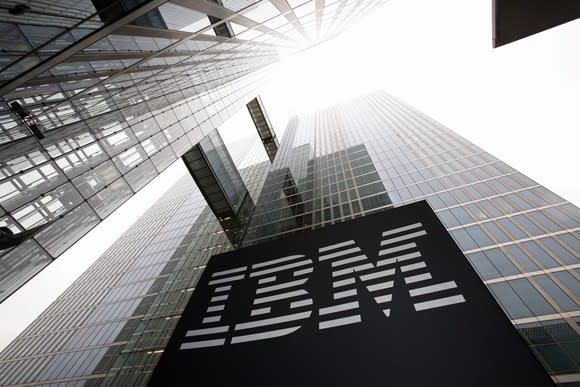3 Things IBM's New CFO Wants You to Know
International Business Machines (NYSE: IBM) announced a surprise executive shuffle earlier this month, just one week before it reported its fourth-quarter results. Martin Schroeter stepped down as CFO, moving to a new role as senior vice president, global markets. IBM veteran James Kavanaugh, previously in charge of IBM's transformation efforts, ascended to the CFO position.
The fourth-quarter earnings conference call was Kavanaugh's first chance in his new role to explain to analysts and investors how IBM's transformation efforts were shaping up. Here are three key quotes from the new CFO.

Image source: IBM.
Currency is finally helping the top line
Around two-thirds of IBM's annual revenue comes from outside the United States. This means that changes in foreign exchange rates can cause IBM's top line to swing up and down due to currency translation effects. The U.S. dollar began strengthening against major currencies like the Euro in 2014. In 2015, and to a lesser extent in 2016 and most of 2017, this led to a reduction in reported revenue growth.
The pendulum finally swung in the opposite direction during the fourth-quarter of 2017. Kavanaugh explained the impact:
Five years we've been living with this? And it's been a dramatic drain on our portfolio overall just given the dynamics of how much business we do outside U.S. dollar-denominated. But currency is finally a tailwind to the IBM company of 2.7 points here in the fourth quarter, which was about a $600 million help on the top line. And that's driven from a variety of FX rates across different countries.
IBM guided for revenue growth in 2018, and Kavanaugh made clear that first-quarter revenue will grow no matter the basis: "And in the first quarter, we will deliver revenue growth, both at actual rates and at constant currency."
While currency is currently benefiting the top line, translation effects and the impact of hedges are working against the bottom line. But for a company that failed to grow revenue for more than five years, a revenue boost from currency is a breath of fresh air.
Hardware sales are growing
While IBM is no longer a hardware-centric company, hardware is still a vital component of the overall business. IBM sells three types of hardware -- mainframe systems, POWER systems, and storage. All three categories posted growth during the fourth quarter.
Kavanaugh discussed the success of the latest z14 mainframe system, which began shipping in September and produced 71% year-over-year growth in the fourth quarter: "And now our MIPS [million instructions per second] installed base has grown double digits year-to-year, and it's 2.5 times the last 10 years. So this performance is, right now, above the prior cycle and consistent with z12 a few years ago."
On the new POWER9 architecture:
Power grew 15%. We started shipping the first POWER9 architecture with the [CORAL supercomputer] win... and we'll roll the rest of that out, our low-end, starting later in the first half and early in the second half. So we look for continued momentum in our Power portfolio overall.
And on the storage business: "...this is the first year in a long time, for 4 quarters in a row, we've grown storage. And that's been based on the great work our storage team has done about repositioning their portfolio, leveraging and growing share in flash, but it's also about software-defined and also, more importantly, as we move forward, object storage that will continue to look for growth."
Investments in growth will continue
A component of IBM's transformation over the past five years has been a shift in resources from slumping legacy businesses to growth businesses like cloud computing, artificial intelligence, and security. This shift required IBM to make investments, and the intensity of those investments won't be changing in 2018, according to Kavanaugh:
In 2018, we'll maintain a high level of investment. This is important as we continue to build out capabilities in AI, in cloud, in security and in blockchain, just to name a few. As always, we'll look for more productivity in our spend base, especially in our Services business, where we'll continue to remix our skills to new opportunities.
The two services segments suffered from slumping margins in the fourth quarter, and rumors have been swirling over the past week of a possible reorganization of those businesses. IBM didn't talk about any plans, but an announcement of some sort aimed at making the services businesses more efficient and repositioning them for the new cloud-heavy IBM could be coming this year.
IBM's turnaround took two steps forward and one step back with its fourth-quarter report. Revenue is growing again, but a combination of currency and tax issues are expected to lead to flat earnings in 2018. That may not be enough to convince the market that IBM's comeback is on track.
More From The Motley Fool
Timothy Green owns shares of IBM. The Motley Fool has no position in any of the stocks mentioned. The Motley Fool has a disclosure policy.
